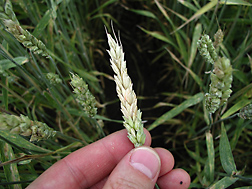This page has been archived and is being provided for reference purposes only. The page is no longer being updated, and therefore, links on the page may be invalid.
Read the magazine story to find out more. |
|
|
Scientists Pit Bacteria against Fungi to Protect Wheat
Por Jan SuszkiwApril 3, 2008
Beneficial flower-dwelling bacteria could soon join the fight against Fusarium graminearum, the fungus that causes Fusarium head blight disease ("scab") in wheat, barley and other cereal crops.
According to Agricultural Research Service (ARS) plant pathologist David Schisler, the naturally occurring bacteria may compete with F. graminearum for nutrients exuded by the wheat plant's anthers.
One such nutrient, choline, is rich in carbon that both the bacteria and fungus need to grow. F. graminearum also appears to rely on choline as a chemical cue to send a germ tube into the anthers' tissues. Farmers feel the pinch—economically speaking—when such fungal breaches lead to shriveled, chalky-white kernels, notes Schisler, in the ARS Crop Bioprotection Research Unit at Peoria, Ill. The beneficial bacteria cause no such harm to wheat and aren't considered a danger to consumers.
In greenhouse studies and field tests, Schisler and Ohio State University plant pathologist Mike Boehm augmented wheat's natural community of the beneficial bacteria, using laboratory cultures, after the crop began flowering. This gave the bacteria an edge in consuming the choline, so less of the nutrient was available to cue the fungus.
In tests, spraying formulations of the beneficial bacteria on plots of two commercial wheat cultivars reduced the severity of scab disease by as much as 63 percent.
A Pseudomonas species dubbed AS 64.4 was the best all-around performer out of 123 choline-metabolizing (CM) bacterial strains the researchers originally isolated from wheat anthers and examined in the laboratory for scab suppression activity.
Ultimately, the CM strains could join other scab-fighting microbes Schisler's group has studied, including yeasts and antibiotic-secreting bacteria. Schisler envisions combining them in a biopesticide formulation that farmers could spray onto wheat as added insurance against scab.
Read more about the research in the April 2008 issue of Agricultural Research magazine.
ARS is the U.S. Department of Agriculture's chief scientific research agency.

